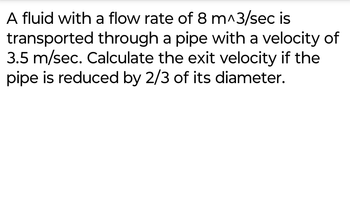
University Physics Volume 1
18th Edition
ISBN: 9781938168277
Author: William Moebs, Samuel J. Ling, Jeff Sanny
Publisher: OpenStax - Rice University
expand_more
expand_more
format_list_bulleted
Question
Please include simple diagram in your solution for better understanding.
Subject: fluid mechanics
COURSE: MECHANICAL ENGINEERING

Transcribed Image Text:A fluid with a flow rate of 8 m^3/sec is
transported through a pipe with a velocity of
3.5 m/sec. Calculate the exit velocity if the
pipe is reduced by 2/3 of its diameter.
Expert Solution
This question has been solved!
Explore an expertly crafted, step-by-step solution for a thorough understanding of key concepts.
Step by stepSolved in 2 steps with 1 images

Knowledge Booster
Similar questions
- (a) Verify that a 19.0% decrease in laminar flow through a tube is caused by a 5.00% decrease in radius, assuming that all other factors remain constant. (b) What increase in flow is obtained from a 5.00% increase in radius, again assuming all other factors remain constant?arrow_forwardWater emerges straight down from a faucet with a 1.80-cm diameter at a speed of 0.500 m/s. (Because of the construction of the faucet, there is no variation in speed across the stream.) (a) What is flow rate in cm3/s? (b) What is the diameter of the stream 0.200 m below the faucet? Neglect any effects due to surface tension.arrow_forwardWhat is the average flow rate in cm3/s of gasoline to the engine of a car traveling at 100 km/h if it averages 10.0 km/L?arrow_forward
- Water is moving at a velocity of 2.00 m/s through a hose with internal diameter of 1.60 cm. (a) What is the flow rate in liters per second? (b) The fluid velocity in this hose's nozzle is 15.0 m/s. What is the nozzle's inside diameter?arrow_forwardA small artery has a length of 1.1103m and a radius of 2.55105m . If the pressure drop across the artery is 1.3 kPa, what is the flow rate through artery? (Assume Eat the temperature 37°C)arrow_forwardAn oil gusher shoots crude 25.0 m the through a pipe with a 0.100-m diameter. Neglecting resistance but not resistance of the pipe, and assuming laminar flow, calculate pressure at be entrance of be 50.0-m-Iong vertical pipe. Take of the oil to be 900 kg/m3 and its viscosity to be 100(N/m2) s (or 1.00 Pa s). Note that you must take into account the pressure due to 50.0-m column of oil in pipe.arrow_forward
- Calculate the Reynolds numbers for the flow of water through (a) a nozzle with a radius of 0.250 cm and (b) a garden hose with a radius of 0.900 cm, when the nozzle is attached to the hose. The flow rate through hose and nozzle is 0.500 us. Can the flow in either possibly be laminar?arrow_forwardWater is moving at a velocity of 2.00 m/s through a hose with an internal diameter of 1.60 cm. (a) What is the flow rate in liters per second? (b) The fluid velocity in this hose's nozzle is 15.0 m/s. What is the nozzle's inside diameter?arrow_forwardSuppose you have a wind speed gauge like the pitot tube shown in Figure 14.32. By what factor must wad speed increase to double the value of h in the manometer? Is independent of be moving fluid and be fluid the Figure 14.32 Measurement of fluid speed on Bernoulli’s principle. (a) A manometer is connected to two tubes close together and small enough not to disturb the flow. Tube 1 is open at the end facing the flow. A dead spot having zero speed is created there. Tube 2 has an opening on the side, so the fluid has a speed v across; thus, pressure there drops. The difference in pressure at the manometer is 12v22 , so h is proportional to . 12v22 (b) This type of velocity measuring device is a Prandtl tube, also known as a pitot tube.arrow_forward
- Is there a limit to the height to which an entrainment device can raise a fluid? Explain your answer.arrow_forwardWhat fraction of ice is submerged when it floats in freshwater, given the density of water 0°C is very close to 1000 kg/m3?arrow_forwardArchimedes' principle can be used to calculate the density of a fluid as well as that of a solid. Suppose a chunk of iron with a mass of 390.0 g in air is found to have an apparent mass of 350.5 g when completely submerged in an unknown liquid. (a) What mass of fluid does the iron displace? (b) What is the volume of iron, using its density as given Table 14.1? (c) Calculate the fluid's density and identify it.arrow_forward
arrow_back_ios
SEE MORE QUESTIONS
arrow_forward_ios
Recommended textbooks for you
 University Physics Volume 1PhysicsISBN:9781938168277Author:William Moebs, Samuel J. Ling, Jeff SannyPublisher:OpenStax - Rice University
University Physics Volume 1PhysicsISBN:9781938168277Author:William Moebs, Samuel J. Ling, Jeff SannyPublisher:OpenStax - Rice University Principles of Physics: A Calculus-Based TextPhysicsISBN:9781133104261Author:Raymond A. Serway, John W. JewettPublisher:Cengage Learning
Principles of Physics: A Calculus-Based TextPhysicsISBN:9781133104261Author:Raymond A. Serway, John W. JewettPublisher:Cengage Learning College PhysicsPhysicsISBN:9781938168000Author:Paul Peter Urone, Roger HinrichsPublisher:OpenStax College
College PhysicsPhysicsISBN:9781938168000Author:Paul Peter Urone, Roger HinrichsPublisher:OpenStax College Physics for Scientists and Engineers: Foundations...PhysicsISBN:9781133939146Author:Katz, Debora M.Publisher:Cengage Learning
Physics for Scientists and Engineers: Foundations...PhysicsISBN:9781133939146Author:Katz, Debora M.Publisher:Cengage Learning Physics for Scientists and Engineers, Technology ...PhysicsISBN:9781305116399Author:Raymond A. Serway, John W. JewettPublisher:Cengage Learning
Physics for Scientists and Engineers, Technology ...PhysicsISBN:9781305116399Author:Raymond A. Serway, John W. JewettPublisher:Cengage Learning An Introduction to Physical SciencePhysicsISBN:9781305079137Author:James Shipman, Jerry D. Wilson, Charles A. Higgins, Omar TorresPublisher:Cengage Learning
An Introduction to Physical SciencePhysicsISBN:9781305079137Author:James Shipman, Jerry D. Wilson, Charles A. Higgins, Omar TorresPublisher:Cengage Learning

University Physics Volume 1
Physics
ISBN:9781938168277
Author:William Moebs, Samuel J. Ling, Jeff Sanny
Publisher:OpenStax - Rice University

Principles of Physics: A Calculus-Based Text
Physics
ISBN:9781133104261
Author:Raymond A. Serway, John W. Jewett
Publisher:Cengage Learning

College Physics
Physics
ISBN:9781938168000
Author:Paul Peter Urone, Roger Hinrichs
Publisher:OpenStax College

Physics for Scientists and Engineers: Foundations...
Physics
ISBN:9781133939146
Author:Katz, Debora M.
Publisher:Cengage Learning

Physics for Scientists and Engineers, Technology ...
Physics
ISBN:9781305116399
Author:Raymond A. Serway, John W. Jewett
Publisher:Cengage Learning

An Introduction to Physical Science
Physics
ISBN:9781305079137
Author:James Shipman, Jerry D. Wilson, Charles A. Higgins, Omar Torres
Publisher:Cengage Learning